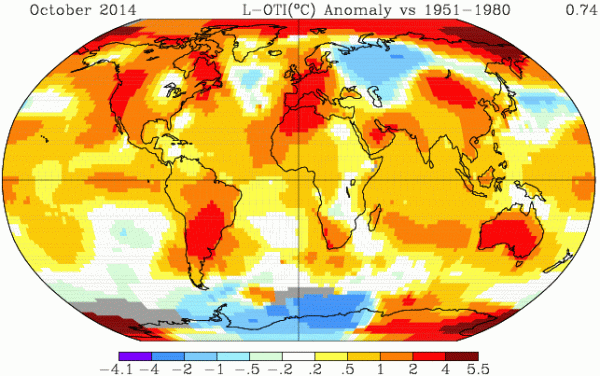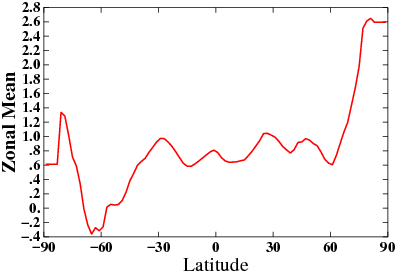NASA:
October 2014 Tied For Hottest on Record
19
November, 2014
(October was again a global temperature record setter. Image source: NASA.)
NASA’s
monthly global temperature analysis is in and the results are once
again record-making. For according to NASA’s global monitor, world
temperatures were 0.76 degrees Celsius above the Earth average for
the mid 20th Century.
This
high temperature departure ties 2005 for hottest in NASA’s 136 year
record. A temperature level that global ice core data points toward
being hotter than at any time in the past 400,000 years. A record hot
month in a string of record hot months for 2014. A resurgence to
record high marks amidst an unprecedented spate of rising
temperatures that has lasted now for more than a century running.
(Global temperatures have risen by more than 1 degree C above their low mark at the start of the 20th Century. It is a human-driven pace of warming 15-20 times faster than at the end of the last ice age. Image source: NASA)
Polar
Amplification Again Prominent
As
in recent months, hottest temperatures were again focused near the
poles. The northern polar region in particular observed much hotter
than normal readings with a very large zone experiencing +2 to +5.5
degrees C above average temperatures for the entire month. East
Antarctica also saw much warmer than normal temperatures with monthly
averages spiking from +2 C to more than 4 C above the 20th Century
average.
Overall,
much of the world showed hotter than normal temperatures with cooler
than normal readings confined to sections of the Southern Ocean and
Eastern Europe. Small and isolated pockets of cooler than normal
readings were found in diminutive oceanic zones. Meanwhile, the rest
of the world experienced warmer than normal to much warmer than
normal readings
(Zonal temperature departures by latitude. Image source: NASA)
Zonal
readings also showed very strong polar amplification in the Northern
Hemisphere with surface temperatures averaging at 2.6 degrees Celsius
above normal in the region above 75 degrees North Latitude. A spike
in temperature to +1.3 C above average was also observed in the
region of 80 degrees South Latitude.
The
Southern Ocean again appears to be the primary zonal heat sink as the
only region showing below average temperatures in the range of -0.38
C below average. As we have seen in previous analysis, this region is
currently the principle atmosphere-to-ocean heat transfer band. Ocean
heat uptake in this region has been shown through recent studies to
have resulted in very rapid warming of the top 700 meters of Southern
Hemisphere ocean waters. It has also played a role in the more rapid
glacial destabilization observed among Antarctica’s increasingly
fragile ice sheets and ice shelves.
Polar
Amplification Sees Late Fall Vortex Disruption, Severe Dipole
Anomalies
Northern
Hemisphere polar amplification is a primary contributor to the polar
vortex disruptions and extreme Jet Stream distension we’ve seen
since about 2005. Current conditions also indicate an extraordinary
dipole again developing with heat pooling in the Arctic near Alaska
and in the maritime zone between the Kara Sea and Greenland. Already
in November, this has caused an extreme meridonal avection of polar
cold air over the continents even as warm air drives north toward the
pole over Atlantic and Pacific Ocean regions.
(Warm air invasion of the Arctic forcing temperatures to 1.9 C above average drives polar air over Central Asia and Eastern North America on November 19 of 2014. Such displacements of cold air during Northern Hemisphere winter are directly tied to global-warming related polar amplification. Image source: GFS/University of Maine)
2014
Close to Hottest On Record
Currently,
NASA’s global temperature average for the first ten months of 2014
puts the year at 0.664 C above the global average. 2010, the previous
hottest year on record, stood between 0.66 and 0.67 degrees hotter
than the 20th Century average. So we are now in record-making
territory for 2014. Any further months with average temperatures
above 0.67 C would continue to cement 2014 as a new record holder.
In
any case, the excessive heat for 2014 is at least likely to place it
among the top 1-4 hottest years even if November and December show
less extreme warm temperature departures. An extraordinary degree of
warmth for a year in which official El Nino status has yet to be
declared.
With
global political leaders retaining an overall laissez faire attitude
to positive action on climate change and with powerful fossil fuel
interests gaining power in the US Congress (Republicans), it is
unfortunately very likely that ongoing massive greenhouse gas
emissions in the range of 50 billion tons of CO2 equivalent each year
will continue to add more heat to the world’s oceans, atmosphere,
and glaciers. As time moves forward, this will vastly increase the
risk of catastrophic weather and geophysical change events. We see
such events now in Brazil, California and across an expanding range
of regions. But these early outliers are mild compared to the
potential extremity of events as time moves forward and catastrophic
emission rates increase.
As
with other brands of risk, including financial risk, the world’s
current economic and political leaders have shown a terrible
ineptitude in working to prevent catastrophic and destabilizing loss.
One hopes that political and economic leaders will wise up. But,
currently, there is very little to indicate that urgently needed
changes will be forthcoming.
Link:
.







No comments:
Post a Comment
Note: only a member of this blog may post a comment.